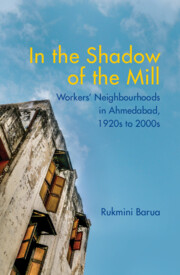Conclusion
Published online by Cambridge University Press: 15 June 2022
Summary
Asiyaben and her husband, Karimbhai, live in Jain Ashram, Vatva, in a two-roomed dwelling painted blue. Asiyaben's family was one of the area's ‘original’ residents and was said to have owned a large parcel of land, including where the Jain temple and the Sabarmati relocation flats now stand. Karimbhai used to work in the Vatva industrial estate and now drives an autorickshaw; Asiyaben takes in subcontracted sewing work. Their home is decorated in a fashion fairly typical in Vatva—a crockery stand mounted on the wall, displaying the gleaming steel utensils and studio portraits of the family. The greatest attention was devoted to their youngest daughter, Nasreen, whose growth over the years had been lovingly documented, photographed with her parents, her four brothers and a large array of stuffed animals. Nasreen is adopted, and how she became a part of Asiyaben's family is something of a local legend. She was found in 2004, abandoned on the banks of the Sabarmati, still bloody from the birth, wrapped in nothing but a plastic bag with the name ‘Nidhi Hospital, Satellite’. The date is important—it was two years after the Godhra kand, as Asiyaben stressed. While narrating this story to me, Karimbhai mentioned several times that he was quite certain that Nasreen had been born to a rich Hindu family. He gleaned this from the address of the hospital where she is assumed to be born. For there are no Muslims in Satellite—a neighbourhood in western Ahmedabad. The way Karimbhai and Asiyaben perceive the city sets up certain binaries—between Hindus and Muslims, the rich and the poor, the eastern and western banks of the Sabarmati. The congruence of these categories, as this book has shown, is complicated by many other coordinates—of class, employment and histories of residence. Yet the binary framing of identity remains a potent one in the ways in which urban life is experienced and articulated.
One's place in the city, as the above anecdote shows, is historically contingent. This book has explored how workers’ claims on the city were forged and transformed over the course of the twentieth and early twenty-first centuries.
- Type
- Chapter
- Information
- In the Shadow of the MillWorkers' Neighbourhoods in Ahmedabad, 1920s to 2000s, pp. 266 - 272Publisher: Cambridge University PressPrint publication year: 2022

